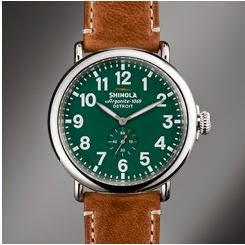A Shinola mechanical watch could soon be a reality, according to Steve Bock, CEO of Shinola, Detroit, makers of quartz watches, bicycles, leather goods, and soon furniture.
In an interview at Baselworld 2014, Bock told me that the pieces to the puzzle are basically in place; it's just a matter of timing (no pun intended), and how a mechanical wristwatch fits into the company's overall vision of being a "design company" and not just a "watch company."
 |
| Steve Bock |
"Where we will obtain the mechanical components, and how we will retrain our assembly staff will be two big issues," says Bock. "But we have no reason to believe that either will be a stumbling block. With our success so far, we have people knocking at our door to help us in any direction that we wish to go."
Shinola's big news at Baselworld 2014 was the announcement of their new limited lifetime warranty, which goes into effect not only for all new Shinola quartz watches sold, but is retroactive for all watches sold previously. In case of defects, all components (excluding battery, leather strap and buckle) are covered by the warranty, and will be repaired (or the watch will be replaced) free of charge. If the exact model is not available for replacement, a watch of equal value and similar style will be provided. A copy of the receipt and/or your completed warranty card is required as proof of purchase. A check or money order payable to Shinola/Detroit, LLC in the amount of $25.00 as service and handling fee must be included for all warranty and repair services. The fee is subject to change.
 |
| A "Runwell" model from the company's collection. |
Shinola says the warranty is unique in the industry, and Bock says it speaks to the confidence not only in the watches themselves, but to the company's confidence of being around for a very long time.
Another issue will be price. Shinola's current entry level price for a quartz timepiece is about $500. While Bock declined to get into specifics, it's a sure bet that a mechanical wristwatch could not be produced at that price level, at least not one of any quality. Currently, the entry price for a man's watch with a Swiss-made automatic mechanical movement is about $1,000.
"It (producing a mechanical watch) is over the horizon, but not that far over the horizon," says Bock. "If you come back and talk to us a year from now, I think we would have a more specific answer for you."
Shinola's next big announcement will be its launch into the furniture business, which will bring back a manufacturing sector long crippled in the USA by migration of that industry to Asia. The move is designed to further enhance Shinola's goal of being known as a "design company," rather than just a watch company, though watch sales currently make up about 85% of Shinola's business, according to Bock.
Look for my complete story on Shinola in the May/June issue of the NAWCC's Watch & Clock Bulletin, out in about a week.
Bye for now,
Bruce